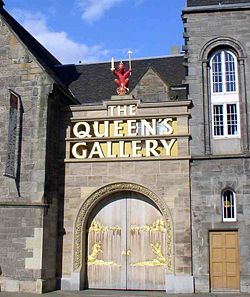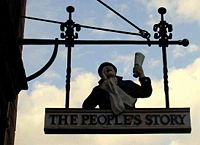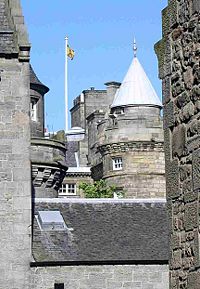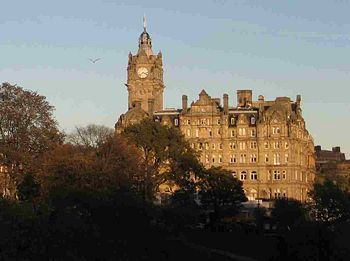Edinburgh/External Links
Jump to navigation
Jump to search

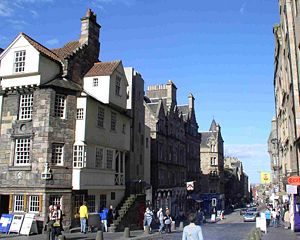
- Please sort and annotate in a user-friendly manner and consider archiving the URLs behind the links you provide. See also related web sources.
Museums and Galleries
- Adjacent to Holyrood Palace, the Queens Gallery displays exhibitions of art from the Royal Collection.
- Edinburgh CastleOne of the UK's leading tourist attractions, the Castle's features include St Margaret's Chapel - Edinburgh's oldest building, dating from the 1100s; Crown Square - the main courtyard, developed in the 15th century; The Great Hall with a hammerbeam roof built by James IV; The Half Moon Battery, from the late 16th century; and The Scottish National War Memorial added after the First World War. The Edinburgh Military Tattoo is held each August in the esplanade outside the Castle.
- The City of Edinburgh Museums and Galleries Includes information on The Museum of Childhood and The Writers' Museum.
- The National Galleries of Scotland
- National Museum of Scotland Chambers' Street
- National War Museum at Edinburgh Castle
- National Museums Collection Centre Granton
- Surgeons' Hall Museums Royal College of Surgeons of Edinburgh, Nicolson Street
- City Art Centre Holds the City's collection of Scottish Art, and hosts temporary exhibitions.
- Georgian House at 7 Charlotte Square. Owned by the National Trust for Scotland. One of Robert Adam's designs for Charlotte Square, considered a masterpiece of urban architecture, and now restored as a typical 1790-1810 mansion. China, silver, paintings and furniture are on display.
- Gladstone’s Land, in the Lawnmarket, Royal Mile. Owned by the National Trust for Scotland, this is the 17th century tenement home of an affluent merchant.

(CC) Photo: Citizendium
John Knox House consists of two town houses (or "lands") with the earlier part constructed about 1470 as part of the redevelopment of the city's walls. The exterior of the front house is much the same as that created in 1560.
John Knox House consists of two town houses (or "lands") with the earlier part constructed about 1470 as part of the redevelopment of the city's walls. The exterior of the front house is much the same as that created in 1560.
- John Knox House
- The Leith Gallery Scottish contemporary art
- Royal Botanic Gardens founded in 1670 and moved to its present location in Inverleith in 1820.
- The National Gallery Designed by William Playfair, this is one of the finest galleries in Britain, containing works by Tintoretto, Titian, Poussin, Claude Lorraine, Rembrandt, Reynolds, Gainsborough, Chardin, Antonio Canova and Turner, as well as French Impressionists, and Scottish artists.
- Lady Stair’s House/Writer’s Museum on the Royal Mile, displays manuscripts, relics and memorabilia of Robert Burns, Sir Walter Scott and R.L. Stevenson.
- The Fruitmarket Gallery Changing international exhibitions of contemporary art, in the former Fruit Market south of Waverley Station in the center of Edinburgh.
- The Museum of Edinburgh, formerly known as Huntly House, occupies 16th and 17th century buildings in the heart of the Old Town. Exhibits include:the feeding bowl and collar belonging to Greyfriars Bobby; the National Covenant, the petition for religious freedom signed by Scotland’s Presbyterians in 1638; and the original plans for Edinburgh’s New Town drawn by architect James Craig.
- The Museum of Childhood on the Royal Mile, displays toys, costumes, books, dolls and games.
- National Portrait Gallery Queen St. Among the portraits on display are Allan Ramsay’s portrait of the philosopher David Hume, Alexander Nasmyth’s portrait of Robert Burns and Sir Henry Raeburn’s portrait of Sir Walter Scott.
- National Library of Scotland on George IV Bridge holds over 8 million books, thirteen million printed items and more than 1.6 million maps. The collection includes copies of the Gutenberg Bible, the original manuscript of Charles Darwin's Origin of Species, and Scotorum historiae a prima gentis origine (Hector Boece, 1527): the first printed book dedicated to the history of Scotland.
- The People's Story is housed in the late 16th century Canongate Tolbooth opposite the Museum of Edinburgh, on The Royal Mile. ' The People's Story ' uses oral history, reminiscence, and written sources to tell the story of the lives, work and leisure of the ordinary people of Edinburgh, from the late 18th century to the present.
- Mary King Close
Tourist attractions
- Edinburgh and the Lothians Tourist Board
- Greyfriars Kirk
- Edinburgh's Flodden Wall (Old Town)
- A Tour of the City of Edinburgh from The Department of Geography at The University of Edinburgh
- the Palace of Holyroodhouse, founded as a monastery in 1128, is The Queen's official residence in Scotland. Mary, Queen of Scots lived here between 1561 and 1567. Today, the Palace is the setting for State ceremonies and official entertaining, and is open to the public when the Queen is not in residence there. Near the Queen's supper room, a brass tablet in the floor marks where the body of David Rissio, Queen Mary's secretary, was left after being stabbed repeatedly by several nobles. In 1745 the Palace was occupied by Prince Charles Edward Stuart (Bonnie Prince Charlie), the last Stuart to reside there.
- Holyrood Park (also known as the Queen's Park, because it is owned by the Queen) is probably the largest area of natural landscape remaining in the centre of any European city. The Park's 650 acres contains Arthur's Seat, Dunsapie Loch, the ancient ruin of St. Anthony's Chapel, and the Salisbury Crags.
- The Royal Observatory on Calton Hill
- Dynamic EarthVisitor attraction run by a charitable trust committed to the education and lifelong learning of Earth sciences
- The Scott Monument on Princes St. is a 200 ft. high neo-Gothic spire commemorating the poet and novelist Sir Walter Scott(1771-1832) with 64 statuettes of Scott's novels' characters. Four viewing platforms (287 steps by narrow stairs to the top) allow dramatic views of Edinburgh. Scott's novels were enormously popular in the early 19th century, and he is said by some modern scholars to have had a seminal influence on the development of the European novel genre, but his popularity with readers had declined markedly by the end of the 19th century and never recovered.
- Scotch Whisky Heritage Centre on the Royal Mile is an exhibition about the whisky making process.
- Nelson's Monument on Calton Hill is a 106 ft. tall, tiered, circular tower with viewing gallery overlooking the city. It commemorates Admiral Lord Nelson's victory and death at the battle of Trafalgar on 21 October 1805.
- The Royal Yacht Britannia is moored at Ocean Terminal, Leith. The Royal Yacht Britannia was launched at John Brown's Shipyard in Clydebank in 1953. From then until her last voyage in 1997, the Royal Yacht carried The Queen and the Royal Family on 968 official voyages.
- The Edinburgh Dungeon is one of Edinburgh’s more unpleasant tourist “attractions”, displaying instruments of torture, and relating tales of horror and cruelty with gleeful prurience and a cavalier disregard for historical veracity.
- Edinburgh Zoo, opened in 1913
- Camera Obscura and World of Illusions on Castlehill
Just outside Edinburgh
- Lauriston Castle
- Roslin Chapel, particularly popular with tourists since the success of the novel The DaVinci Code and the subsequent movie.
- Hopetoun House; a stately home, part built between 1699 and 1702 and part designed between 1720 and 1750 by the Adam brothers (William, Robert and John)
- Inchcolm Island and Abbey; medieval abbey, founded in 1123
- Bass Rock, a sea-bird sanctuary in the Firth of Forth two miles east of North Berwick, holding approximately 10% of the world population of North Atlantic Gannets. The first inhabitant of Bass Rock was Baldred, a monk of Lindisfarne who was sent to the Lothians in the 8th century to convert its heathen inhabitants to Christianity. In the 15th century, King James I imprisoned political enemies on the Bass Rock, including, in 1428, 14 year-old Neil Bhass Mackay After the murder of King James in 1437, Neil escaped and was proclaimed 8th Chief of the Clan Mackay. In the early 16th century, Mary Queen of Scots kept a garrison of 100 men, including some French troops, stationed on the rock. A small chapel on the Rock was built around 1491 and dedicated to Saint Baldred in 1546.
- The Forth Bridge This dramatic Railway Bridge spanning the Firth of Forth was the world’s first major steel bridge, with girder spans of 521 m (1710 ft). Begun in 1883, it was opened on 4 March 1890 when Edward, Prince of Wales tapped a ‘golden’ rivet into place.
Theatres
- Edinburgh Theatres website
- The Royal Lyceum Theatre
- Assembly Theatre
- Pleasance Theatre
- The King's Theatre
- The Festival Theatre
- The Edinburgh Playhouse 3000-seats; musicals
- The Traverse Theatre New writing theatre
Information
- City of Edinburgh Council
- Capital Review Economic Data
- City of Edinburgh Population and Demographic Information
- Edinburgh by Numbers - facts and figures
Hotels
- The George
- The Balmoral Hotel, at the east end of Princes Street
- The Caledonian Hotel, at the west end of Princes Street
